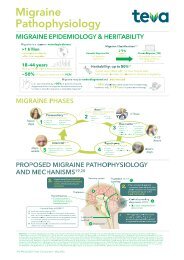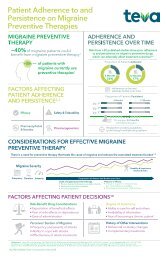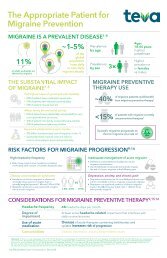The breadth of real-world evidence for BOTOX® in Chronic Migraine*
You also want an ePaper? Increase the reach of your titles
YUMPU automatically turns print PDFs into web optimized ePapers that Google loves.
PI
BOTOX ® (botulinum toxin type A) Abbreviated Prescribing Information
Presentation: Botulinum toxin type A (from clostridium botulinum), 50, 100 & 200 Allergan Units/vial. Indications:
Management of Neurologic disorders: blepharospasm, hemifacial spasm and associated focal dystonias, cervical dystonia
(spasmodic torticollis). Focal spasticity associated with dynamic equinus foot deformity due to spasticity in ambulant
paediatric cerebral palsy patients (two years or older), focal spasticity of the ankle and foot in adult post stroke patients
and focal spasticity of the wrist and hand in adult post stroke patients. Symptom relief in adults fulfilling criteria for chronic
migraine (defined as headaches on ≥15 days per month of which at least 8 days with migraine) in patients who have
responded inadequately or are intolerant of prophylactic migraine medications. Bladder disorders: idiopathic overactive
bladder with symptoms of urinary incontinence, urgency and frequency in adult patients who have an inadequate response
to, or are intolerant of, anticholinergic medication and urinary incontinence in adults with neurogenic detrusor
overactivity resulting from neurogenic bladder due to stable sub-cervical spinal cord injury, or multiple sclerosis. Skin and
skin appendage disorder: Persistent severe primary hyperhidrosis of the axillae, which interferes with the activities of
daily living and is resistant to topical treatment. Dosage and Administration: See Summary of Product Characteristics
for full information. Botulinum toxin Units are not interchangeable from one product to another. BOTOX must only be reconstituted
with sterile sodium chloride 9 mg/ml (0.9%) solution for injection. Neurologic disorders: Focal Spasticity
associated with paediatric cerebral palsy: Inject using a 23-26 gauge/0.60-0.45 mm needle into the medial and lateral
heads of the affected gastrocnemius muscle. In hemiplegia initial recommended total dose, 4 Units/kg body weight in
affected limb; in diplegia, 6 Units/kg body weight divided between the affected limbs. Total dose should not exceed 200
Units. Repeat dose not more frequently than every three months. Blepharospasm: Inject using a 27-30 gauge/0.40-
0.30mm needle. Initially, 1.25–2.5 Units injected into the medial and lateral orbicularis oculi of the upper lid and the lateral
orbicularis oculi of the lower lid. Subsequently, the dose may be increased up to two-fold. Initial dose should not exceed
25 Units per eye. Total dose should not exceed 100 Units every 12 weeks. Hemifacial spasm: Treat as for unilateral
blepharospasm. Inject other affected facial muscles as needed. Cervical dystonia: Inject using a 25-30 gauge/0.50-0.30
mm needle. Tailor dosing to individual patient based on muscle mass and degree of hypertrophy or atrophy. Do not inject
sternomastoid muscle bilaterally. No more than 200 Units for first course. Subsequently, maximum total dose of 300
Units. Treatment intervals of less than 10 weeks are not recommended. Focal upper limb spasticity associated with
stroke: Inject using a 25, 27 or 30 gauge needle. Total dose 200 to 240 Units, divided among selected muscles. Needle
length should be determined based on muscle location and depth. Tailor dose and number of sites based on size, number
and location of muscles involved, the severity of spasticity, the presence of local muscle weakness, and the patient response
to previous treatment. Re-injections should not occur before 12 weeks. Focal lower limb spasticity associated
with stroke: Inject using a sterile 25, 27 or 30 gauge needle. Needle length should be determined based on muscle location
and depth. Localisation of the involved muscles with electromyographic guidance or nerve stimulation techniques
may be useful. Multiple injection sites may allow BOTOX to have more uniform contact with the innervation areas of the
muscle and are especially useful in larger muscles. The recommended dose for treating adult lower limb spasticity involving
the ankle and foot is 300 - 400 Units divided among up to 6 muscles. 75 Units across 3 sites in gastrocnemius medial
head, gastrocnemius lateral head, soleus and tibialis posterior; 50 Units across 2 sites in flexor hallucis longus and flexor
digitorum longus; 25 Units in 1 site in flexor digitorum brevis. Re-injections should not occur before 12 weeks. The maximum
recommended dose at one treatment is 400 Units. Chronic migraine: Inject using 30 gauge, 0.5 inch needle, or 1
inch needle for thicker muscles in neck region if required. Inject 0.1 ml (5 Units) intramuscularly to 31 and up to 39 injection
sites, divided across seven specific head/neck muscle areas including frontalis, corrugator, procerus, occipitalis,
temporalis, trapezius and cervical paraspinal muscles. Inject bilaterally, with the exception of procerus. Total dose 155
Units -195 Units. Bladder disorders: Overactive bladder: Reconstituted BOTOX (100 Units/10 ml) is injected into the
detrusor muscle via a flexible or rigid cystoscope, avoiding the trigone and base. The bladder should be instilled with
enough saline to achieve adequate visualisation for the injections, but over-distension should be avoided. Needle should
be inserted approximately 2 mm into the detrusor, and 20 injections of 0.5 ml each (total volume 10 ml) should be spaced
approximately 1 cm apart. For the final injection, approximately 1 ml of sterile normal saline should be injected so the full
dose is delivered. The saline used for bladder wall visualisation should not be drained so that patients can demonstrate
their ability to void prior to leaving the clinic. Reinjection should be no sooner than 3 months from the prior bladder injection.
Urinary incontinence due to neurogenic detrusor overactivity: Reconstituted BOTOX (200 Units/30 ml) injected
into the detrusor muscle via a flexible or rigid cystoscope, avoiding the trigone and base. Needle should be inserted approximately
2 mm into the detrusor, and 30 injections of 1 ml each (total volume 30 ml), spaced approximately 1 cm apart.
For final injection, approximately 1 ml of sterile normal saline should be injected so the full dose is delivered. The saline
used for bladder wall visualisation should be drained and patient observed for at least 30 minutes post-injection. Reinjection
should be no sooner than 3 months from the prior bladder injection. Skin and skin appendage disorder:
Primary hyperhidrosis of the axillae: Inject using a 30 gauge needle. Inject 50 Units intradermally into each axilla, evenly
distributed in multiple sites approximately 1-2 cm apart. Repeat injections should be administered when clinical effects
from previous injections diminishes. Injections should not be repeated more frequently than every 16 weeks. In treating
adult patients, including when treating for multiple indications, the maximum cumulative dose should not exceed 400
Units, in a 12 weeks interval Contraindications: Known hypersensitivity to any constituent. Pregnancy or lactation. Presence
of infection at proposed injection site(s). Bladder disorders: Patients who have urinary tract infection at the time of
treatment. Patients with acute urinary retention at the time of treatment, who are not routinely catheterising. Patients
who are not willing and/or able to initiate catheterisation post-treatment if required. Warnings/Precautions: The recommended
dosages and frequencies of administration should not be exceeded due to the potential for overdose, exaggerated
muscle weakness, distant spread of toxin and the formation of neutralising antibodies. Initial dosing in treatment
naïve patients should begin with the lowest recommended dose for the specific indication. Prescribers and patients
should be aware that side effects can occur despite previous injections being well tolerated. Side effects related to spread
of toxin distant from the site of administration have been reported sometimes resulting in death, which in some cases was
associated with dysphagia, pneumonia and/or significant debility. The risk of symptoms is probably greatest in patients
who have underlying conditions and comorbidities, including children and adults treated for spasticity or those treated
with high doses. Elderly patients with significant medical history and concomitant medications should be treated with
caution. There are limited clinical data in patients older than 65 years treated for post-stroke spasticity of the ankle and
foot. Dysphagia has also been reported following injection to sites other than the cervical musculature. Caution in patients
with subclinical or clinical evidence of defective neuromuscular transmission, with underlying neurological disorders
and with a history of dysphagia and aspiration. Patients or caregivers should be advised to seek immediate medical
care if swallowing, speech or respiratory disorders arise. Sedentary patients should be cautioned to resume activity gradually.
The relevant anatomy, and any alterations to the anatomy due to prior surgical procedures, must be understood
prior to administration and injection into vulnerable anatomic structures must be avoided. Pneumothorax associated
with injection procedure has been reported. Serious adverse events including fatal outcomes have been reported in patients
who had received off-label injections directly into salivary glands, the oro-lingual-pharyngeal region, oesophagus
and stomach. If serious hypersensitivity reactions occur, further injection should be discontinued and appropriate medical
therapy, such as epinephrine, immediately instituted. Procedure-related injury could occur. Caution should be used in
the presence of inflammation at the proposed injection site(s) or when excessive weakness or atrophy is present in the
target muscle. There have also been reports of adverse events involving the cardiovascular system, including arrhythmia
and myocardial infarction, some with fatal outcomes. New onset or recurrent seizures have been reported, typically in
patients, who are predisposed to experiencing these events. Injections at more frequent intervals or at higher doses may
lead to greater incidence of antibody formation. Clinical fluctuations during the repeated use (as with all botulinum toxins)
may be a result of different vial reconstitution procedures, injection intervals, muscles injected and slightly differing
potency values given by the biological test method used. Paediatric Use: The safety and efficacy in indications other than
those described for the paediatric population has not been established. There have been rare spontaneous reports of
death sometimes associated with aspiration pneumonia in children with severe cerebral palsy after treatment with botulinum
toxin, including following off-label use (e.g. neck area). Extreme caution should be exercised when treating paediatric
patients who have significant neurologic debility, dysphagia, or have a recent history of aspiration pneumonia or
lung disease. Neurologic disorders: Focal spasticity associated with paediatric cerebral palsy and focal spasticity of
the ankle and foot, hand and wrist in adult post- stroke patients: BOTOX is a treatment of focal spasticity that has only
been studied in association with usual standard of care regimens, and is not intended as a replacement for these treatment
modalities. BOTOX is not likely to be effective in improving range of motion at a joint affected by a fixed contracture
and should not be used for the treatment of focal spasticity of the ankle and foot in adult post-stroke patients if muscle
tone reduction is not expected to result in improved function (e.g. improvement in walking), or improved symptoms (e.g.
reduction in pain), or to faciliate care. In addition, improvement in active function may be limited if treatment is initiated
longer than 2 years post-stroke or in patients with less severe ankle spasticity (Modified Ashworth Scale (MAS) < 3). Caution
should be exercised when treating adult patients with post-stroke spasticity who may be at increased risk of fall.
Blepharospasm: Reduced blinking following botulinum toxin injection into the orbicularis muscle can lead to corneal
exposure, persistent epithelial defect, and corneal ulceration, especially in patients with VII nerve disorders. Careful testing
of corneal sensation in eyes previously operated upon, avoidance of injection into the lower lid area to avoid ectropion,
and vigorous treatment of any epithelial defect should be employed. Ecchymosis occurs easily in the soft eyelid tissues.
Because of the anticholinergic activity of botulinum toxin, caution should be exercised when treating patients at risk for
angle closure glaucoma, including patients with anatomically narrow angles. Cervical dystonia: Patients can experience
dysphagia which may be very mild, but could be severe. Dysphagia may persist for two to three weeks after injection, but
has been reported to last up to five months post-injection. Consequent to the dysphagia there is the potential for aspiration,
dyspnoea and occasionally the need for tube feeding. Limiting the dose injected into the sternocleidomastoid muscle
to less than 100 Units may decrease the occurrence of dysphagia. Patients with smaller neck muscle mass, or patients
who receive bilateral injections into the sternocleidomastoid muscle, have been reported to be at greater risk of dysphagia.
Chronic migraine: Safety and efficacy have not been established in prophylaxis of headaches in patients with episodic
migraine (headaches on <15 days per month) or chronic tension type headache. Safety and efficacy in patients with
medication overuse headache (secondary headache disorder) has not been studied. Bladder Disorders: Appropriate
medical caution should be exercised when performing a cystoscopy. In patients who are not catheterising, post-void residual
urine volume should be assessed within 2 weeks post-treatment and periodically as medically appropriate up to 12
weeks. Patients should be instructed to contact their physician if they experience difficulties in voiding as catheterisation
may be required. Overactive bladder: Men with overactive bladder and signs or symptoms of urinary obstruction should
not be treated with BOTOX. Urinary incontinence due to neurogenic detrusor overactivity: Autonomic dysreflexia
associated with the procedure can occur. Prompt medical attention may be required. Skin and Skin Appendage Disorder:
Primary hyperhidrosis of the axilla: Medical history and physical examination, along with specific additional investigations
as required, should be performed to exclude potential causes of secondary hyperhidrosis (e.g. hyperthyroidism,
phaeochromocytoma). Interactions: Theoretically, effect may be potentiated by aminoglycoside antibiotics or spectinomycin,
or other drugs that interfere with neuromuscular transmission. Adverse Effects: See Summary of Product Characteristics
for full information on side effects including details on frequencies. In general, adverse reactions usually occur
within the first few days following injection and are generally transient, but may persist for several months or longer. Local
muscle weakness represents the expected pharmacological action of botulinum toxin in muscle tissue. However, weakness
of adjacent muscles and/or muscles remote from the site of injection has been reported. Localised pain, inflammation,
paraesthesia, hypoaesthesia, tenderness, swelling/oedema, erythema, localised infection, bleeding and/or bruising
have been associated with the injection. Needle-related pain and/or anxiety have resulted in vasovagal responses,
including transient symptomatic hypotension and syncope. Fever and flu syndrome have also been reported after injections
of botulinum toxin. Neurologic Disorders: Focal spasticity associated with paediatric cerebral palsy: Infections
and infestations: Viral infection, ear infection. Nervous system disorders: Somnolence, gait disturbance, paraesthesia.
Skin and subcutaneous tissue disorders: Rash. Musculoskeletal and connective tissue disorders: Myalgia, muscular weakness,
pain in extremity, arthralgia, musculoskeletal stiffness. Renal and urinary disorders: Urinary incontinence. Injury,
poisoning and procedural complications: Fall. General disorders and administration site conditions: Malaise, injection
site pain, asthenia, oedema peripheral. Focal spasticity associated with stroke: Psychiatric disorders: Depression, insomnia.
Nervous system disorders: Hypertonia, hypoasthesia, headache, paraesthesia, incoordination, amnesia. Ear and
labyrinth disorders: Vertigo. Vascular disorders: Orthostatic hypotension. Gastrointestinal disorders: Nausea, paraesthesia
oral. Skin and subcutaneous tissue disorders: Ecchymosis, purpura, dermatitis, pruritus, rash. Musculoskeletal and
connective tissue disorders: Pain in extremity, muscle weakness, arthralgia, musculoskeletal stiffness, bursitis. General
disorders and administration site conditions: Injection site pain, pyrexia, influenza-like illness, injection site haemorrhage,
injection site irritation, asthenia, pain, injection site hypersensitivity, malaise, oedema peripheral. Injury, poisoning
and procedural complications: Fall. Blepharospasm, hemifacial spasm and associated dystonias: Nervous system
disorders: Dizziness, facial paresis, facial palsy. Eye disorders: Eyelid ptosis, punctate keratitis, lagophthalmos, dry eye,
photophobia, eye irritation, lacrimation increase, keratitis, ectropion, diplopia, entropion, visual disturbance, vision
blurred, eyelid oedema, ulcerative keratitis, corneal epithelium defect, corneal perforation. Skin and subcutaneous tissue
disorders: Ecchymosis, rash/dermatitis. General disorders and administration site conditions: Irritation, face oedema,
fatigue. Cervical dystonia: Infections and infestations: Rhinitis, upper respiratory tract infection. Nervous system disorders:
Dizziness, hypertonia, hypoaesthesia, somnolence, headache. Eye disorders: Diplopia, eyelid ptosis. Respiratory,
thoracic and mediastinal disorders: Dyspnoea, dysphonia. Gastrointestinal disorders: Dysphagia, dry mouth, nausea.
Musculoskeletal and connective tissue disorders: Muscular weakness, musculoskeletal stiffness, soreness. General disorders
and administration site conditions: Pain, asthenia, influenza-like illness, malaise, pyrexia. Chronic Migraine: Nervous
system disorders: Headache, migraine, facial paresis. Eye disorders: Eyelid ptosis. Skin and subcutaneous tissue disorders:
Pruritis, rash, pain of skin. Musculoskeletal and connective tissue disorders: Neck pain, myalgia, musculoskeletal
pain, musculoskeletal stiffness, muscle spasms, muscle tightness, muscular weakness, pain in jaw. General disorders and
administration site condition: Injection site pain. Gastrointestinal disorders: Dysphagia. Bladder disorders: Overactive
Bladder: Infections and infestations: Urinary tract infection, bacteriuria. Renal and urinary disorders: Dysuria, urinary
retention, residual urine volume, pollakiuria, leukocyturia. Urinary incontinence due to neurogenic detrusor overactivity:
Infections and infestations: Urinary tract infection. Psychiatric disorders: Insomnia. Gastrointestinal disorders:
Constipation. Musculoskeletal and connective tissue disorders: Muscular weakness, muscle spasm. Renal and urinary
disorders: Urinary retention, haematuria, dysuria, bladder diverticulum. General disorders and administration site conditions:
Fatigue, gait disturbance. Injury, poisoning and procedural complications: Autonomic dysreflexia, fall. Skin and skin
appendage disorder: Primary hyperhydrosis of the axillae: Nervous system disorders: Headache, paraesthesia. Vascular
disorders: Hot flushes. Gastrointestinal disorders: Nausea. Skin and subcutaneous tissue disorders: Hyperhidrosis
(non axillary sweating), skin odour abnormal, pruritus, subcutaneous nodule, alopecia. Musculoskeletal and connective
tissue disorders: Pain in extremity, muscular weakness, myalgia, arthropathy. General disorders and administration site
conditions: Injection site pain, pain, injection site oedema, injection site haemorrhage, injection site hypersensitivity, injection
site irritation, asthenia, injection site reactions.
Marketing Authorisation Number: PA0148/060/1-3. Marketing Authorisation Holder: Allergan Pharmaceuticals
(Ireland) Ltd, Castlebar Road, Westport, County Mayo, Ireland. Legal Category: Prescription. Date of Preparation:
March 2019
Further information is available from: Allergan Limited, Marlow International, The Parkway, Marlow, Bucks SL7 1YL.
Adverse events should be reported to your local regulatory authority and Allergan office
BOTOX ® (botulinum toxin type A (Allergan)) may not be registered in your country or licence terms may vary by country.
Botulinum toxin units are not interchangeable from one product to another; doses recommended in Allergan Units are different from other botulinum toxin preparations.
INT-BTX-2050189
June 2020 (botulinum toxin type A)








